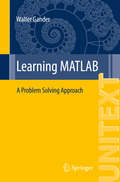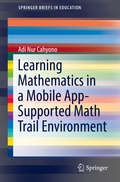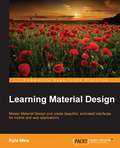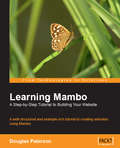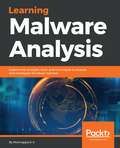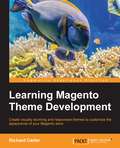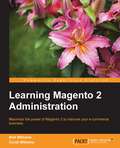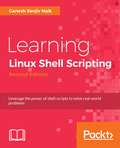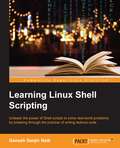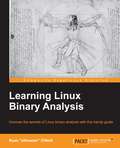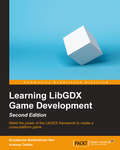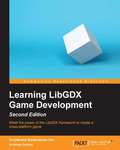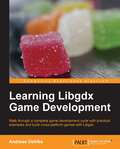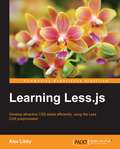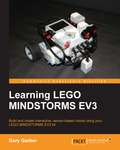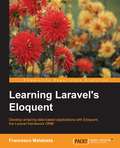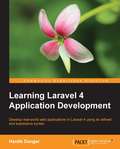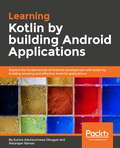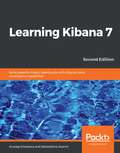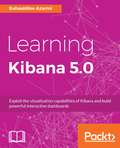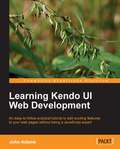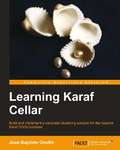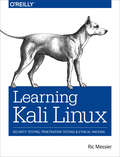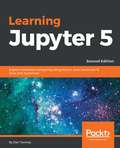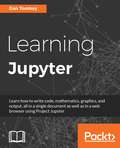- Table View
- List View
Learning MATLAB
by Walter GanderThis comprehensive and stimulating introduction to Matlab, a computer language now widely used for technical computing, is based on an introductory course held at Qian Weichang College, Shanghai University, in the fall of 2014. Teaching and learning a substantial programming language aren't always straightforward tasks. Accordingly, this textbook is not meant to cover the whole range of this high-performance technical programming environment, but to motivate first- and second-year undergraduate students in mathematics and computer science to learn Matlab by studying representative problems, developing algorithms and programming them in Matlab. While several topics are taken from the field of scientific computing, the main emphasis is on programming. A wealth of examples are completely discussed and solved, allowing students to learn Matlab by doing: by solving problems, comparing approaches and assessing the proposed solutions.
Learning Mathematics in a Mobile App-Supported Math Trail Environment (SpringerBriefs in Education)
by Adi Nur CahyonoThis brief presents the results of a study on the development of the mobile app-supported math trail program for learning mathematics. This study is a part of the MathCityMap-Project, a project of the MATIS I Team from IDMI Goethe-Universität Frankfurt, Germany, that comprises math trails around the city that are supported by the use of GPS-enabled mobile phone technology. The project offers an activity that is designed to support students in constructing their own mathematical knowledge by solving the prepared mathematical tasks on the math trail and interacting with the environment, including the digital environment. The brief focuses specifically on the development of a model for a mobile app-supported math trail programme and the implementation of this programme in Indonesia. It offers both an empirical exploration of its implementation as well as critical assessment of students’ motivation in mathematics, their own performance, as well as teachers’ mathematics beliefs. It concludes with a future-forward perspective by recommending strategies for implementation in schools, among the general public of the existing math trails (including its supporting tool). It also discusses strategies for developing and designing new trails and suggests further research in other geographical regions and contexts for continued project development and implementation. Learning Mathematics in a Mobile App-Supported Math Trail Environment articulates an innovative and exciting future for integrating real mathematical tasks and geographic and digital environment into effective mathematics education.
Learning Material Design
by Kyle MewMaster Material Design and create beautiful, animated interfaces for mobile and web applications About This Book * Master the highly acclaimed Material Design paradigm and give your apps and pages the look that everyone is talking about * Get a mix of key theoretical concepts combined with enough practical examples to put each theory into practice so you can create elegant material interfaces with Android Studio and Polymer * Written by Kyle Mew, successful author with over a decade of mobile and web development experience, this book has both the touch of a developer as well as an experienced writer Who This Book Is For This book is ideal for web developers and designers who are interested in implementing Material Design in their mobile and web apps. No prior knowledge or experience of Material Design is required, but some familiarity with procedural languages such as Java and markup languages such as HTML will provide an advantage. What You Will Learn * Implement Material Design on both mobile and web platforms that work on older handsets and browsers * Design stylish layouts with the Material Theme * Create and manage cards, lists, and grids * Design and implement sliding drawers for seamless navigation * Coordinate components to work together * Animate widgets and create transitions and animation program flow * Use Polymer to bring Material Design to your web pages In Detail Google's Material Design language has taken the web development and design worlds by storm. Now available on many more platforms than Android, Material Design uses color, light, and movements to not only generate beautiful interfaces, but to provide intuitive navigation for the user. Learning Material Design will teach you the fundamental theories of Material Design using code samples to put these theories into practice. Focusing primarily on Android Studio, you'll create mobile interfaces using the most widely used and powerful material components, such as sliding drawers and floating action buttons. Each section will introduce the relevant Java classes and APIs required to implement these components. With the rules regarding structure, layout, iconography, and typography covered, we then move into animation and transition, possibly Material Design's most powerful concept, allowing complex hierarchies to be displayed simply and stylishly. With all the basic technologies and concepts mastered, the book concludes by showing you how these skills can be applied to other platforms, in particular web apps, using the powerful Polymer library. Style and approach Learning Material Design combines the theories behind material design with practical examples of how these can be implemented and further reinforcing the guidelines covering style, layout and structure.
Learning Mambo: A Step-by-Step Tutorial to Building Your Website
by Douglas PatersonWritten in a clear, easy-to-read style, the book provides a tutorial for setting up a Mambo website. Each topic is tackled in a practical way with many examples and tasks to develop your skills. A realistic example website is developed incrementally through the book, showing each step in detail. This book is suitable for web developers, designers, webmasters, content editors, and marketing professionals who want develop a fully featured web presence in a simple and straightforward process. No prior knowledge of Mambo is expected, and it does not require any detailed knowledge of programming or web development. Any IT-confident individual will be able to use the book to produce an impressive website.
Learning Malware Analysis: Explore the concepts, tools, and techniques to analyze and investigate Windows malware
by Monnappa K AUnderstand malware analysis and its practical implementationKey FeaturesExplore the key concepts of malware analysis and memory forensics using real-world examplesLearn the art of detecting, analyzing, and investigating malware threatsUnderstand adversary tactics and techniquesBook DescriptionMalware analysis and memory forensics are powerful analysis and investigation techniques used in reverse engineering, digital forensics, and incident response. With adversaries becoming sophisticated and carrying out advanced malware attacks on critical infrastructures, data centers, and private and public organizations, detecting, responding to, and investigating such intrusions is critical to information security professionals. Malware analysis and memory forensics have become must-have skills to fight advanced malware, targeted attacks, and security breaches.This book teaches you the concepts, techniques, and tools to understand the behavior and characteristics of malware through malware analysis. It also teaches you techniques to investigate and hunt malware using memory forensics. This book introduces you to the basics of malware analysis, and then gradually progresses into the more advanced concepts of code analysis and memory forensics. It uses real-world malware samples, infected memory images, and visual diagrams to help you gain a better understanding of the subject and to equip you with the skills required to analyze, investigate, and respond to malware-related incidents.What you will learnCreate a safe and isolated lab environment for malware analysisExtract the metadata associated with malwareDetermine malware's interaction with the systemPerform code analysis using IDA Pro and x64dbgReverse-engineer various malware functionalitiesReverse engineer and decode common encoding/encryption algorithmsPerform different code injection and hooking techniquesInvestigate and hunt malware using memory forensicsWho this book is forThis book is for incident responders, cyber-security investigators, system administrators, malware analyst, forensic practitioners, student, or curious security professionals interested in learning malware analysis and memory forensics. Knowledge of programming languages such as C and Python is helpful but is not mandatory. If you have written few lines of code and have a basic understanding of programming concepts, you’ll be able to get most out of this book.
Learning Magento Theme Development
by Richard CarterThis book is for web designers and developers with existing knowledge of CSS, HTML, and XML, who wish to learn more about Magento-specific theming techniques. Some knowledge of PHP may be useful, but is not necessary.
Learning Magento 2 Administration
by Bret Williams Cyndi WilliamsMaximize the power of Magento 2 to improve your e-commerce business About This Book * Strategic planning for maximizing your Magento 2 store's operations and sales. * Important guidelines and advice for optimizing your Magento 2 store. * Packed with screenshots and step-by-step instructions to leverage the hundreds of Magento 2 features. Who This Book Is For This guide is for store owners who use Magento 2 on a daily basis to operate their online stores. Proprietors will use this guide as a reference for ensuring that they are utilizing the full power of Magento 2. Developers and solution providers will find this guide a helpful tool in identifying opportunities to help their clients navigate the complexity of Magento 2. What You Will Learn * Strategies for creating multiple stores within a single Magento installation. * Use of complex product types such as bundles, downloadables and virtual products. * Configuring payments, shipping and taxes. * Accommodating multiple languages and currencies. * Installing and configuring themes. * Managing content and search engine optimization. * Creating promotions, up-sells and cross-sells. * Leveraging the customer relationship features of Magento 2. * Securing and optimizing your installation. In Detail Magento 2 has been completely re-written and re-designed to take the world's most popular open source e-commerce platform to new heights of productivity and usability. With this overhaul comes improved opportunities to leverage the world's most successful open source e-commerce platform for your online retail and wholesale business. The focus of this book is on operational aspects: those actions you, as a proprietor, can take to give your customers a more delightful shopping experience. In this guide, we delve into all aspects of managing a Magento 2 store, from product creation to marketing, customer management to search engine optimization. This book is not only a step-by-step course in setting up your Magento 2 website, it will be a handy reference as continue to improve and refine your online presence. Style and approach A step-by-step guide where it takes the reader from the planning step all the way through launching a new Magento-powered store by building on the initial sample data included in a default Magento 2 installation. Along the way, we explore using discrete action steps how to leverage the full power of Magento 2 for both simple and advanced uses. Screenshots and step-by-step instructions not only teach the new Magento store administrator, but also serve as a handy reference for the more experienced operators.
Learning Linux Shell Scripting: Leverage the power of shell scripts to solve real-world problems, 2nd Edition
by Ganesh NaikBreak through the practice of writing tedious code with shell scriptsKey FeaturesLearn to impeccably build shell scripts and develop advanced applicationsCreate smart solutions by writing and debugging scriptsA step-by-step tutorial to automate routine tasks by developing scriptsBook DescriptionLinux is the most powerful and universally adopted OS. Shell is a program that gives the user direct interaction with the operating system. Scripts are collections of commands that are stored in a file. The shell reads this file and acts on commands as if they were typed on the keyboard.Learning Linux Shell Scripting covers Bash, GNU Bourne Again Shell, preparing you to work in the exciting world of Linux shell scripting. CentOS is a popular rpm-based stable and secured Linux distribution. Therefore, we have used CentOS distribution instead of Ubuntu distribution. Linux Shell Scripting is independent of Linux distributions, but we have covered both types of distros. We start with an introduction to the Shell environment and basic commands used. Next, we explore process management in Linux OS, real-world essentials such as debugging and perform Shell arithmetic fluently. You'll then take a step ahead and learn new and advanced topics in Shell scripting, such as decision making, starting up a system, and customizing a Linux environment. You will also learn about grep, stream editor, and AWK, which are very powerful text filters and editors. Finally, you'll get to grips with taking backup, using other language scripts in Shell Scripts as well as automating database administration tasks for MySQL and Oracle.By the end of this book, you will be able to confidently use your own shell scripts in the real world.What you will learnFamiliarize yourself with the various text filtering tools available in LinuxUnderstand expressions and variables and how to use them practicallyAutomate decision-making and save a lot of time and effort of revisiting codeGet to grips with advanced functionality such as using traps, dialogs to develop screens & Database administration such as MySQL or OracleStart up a system and customize a Linux systemTaking backup of local or remote data or important files.Use existing other language scripts such as Python, Perl & Ruby in Shell ScriptsWho this book is forLearning Linux Shell Scripting is ideal for those who are proficient at working with Linux and want to learn about shell scripting to improve their efficiency and practical skills.
Learning Linux Shell Scripting
by Ganesh Sanjiv NaikUnleash the power of shell scripts to solve real-world problems by breaking through the practice of writing tedious code About This Book * Learn how to efficiently and effectively build shell scripts and develop advanced applications with this handy book * Develop high quality and efficient solutions by writing professional and real-world scripts, and debug scripts by checking and shell tracing * A step-by-step tutorial to automate routine tasks by developing scripts from a basic level to very advanced functionality Who This Book Is For This book is ideal for those who are proficient at working with Linux and who want to learn about shell scripting to improve their efficiency and practical skills. By the end of this book, you will be able to confidently use your own shell scripts in the real world. What You Will Learn * Familiarize yourself with the various text filtering tools available in Linux * Combine the fundamental text and file processing commands to process data and automate repetitive tasks * Understand expressions and variables and how to use them practically * Automate decision-making and save a lot of time and effort of revisiting code * Get to grips with advanced functionality such as using traps and signals and using dialogs to develop screens * Start up a system and customize a Linux system * Take an in-depth look at regular expressions and pattern matching to understand the capabilities of scripting In Detail Linux is the one of the most powerful and universally adopted OSes. Shell is a program that gives the user direct interaction with the operating system. Scripts are collections of commands that are stored in a file. The shell can read this file and act on the commands as if they were typed on the keyboard. Shell scripting is used to automate day-to-day administration, and for testing or product development tasks. This book covers Bash, GNU Bourne Again SHell, preparing you to work in the exciting world of Linux shell scripting. We start with an introduction to the Shell environment and explain basic commands used in Shell. Next we move on to check, kill, and control the execution of processes in Linux OS. Further, we teach you about the filter tools available in Linux and explain standard output and standard errors devices. Then we will ensure you understand Shell's interpretation of commands and get a firmer grasp so you use them in practice. Next, you'll experience some real-world essentials such as debugging and perform Shell arithmetic fluently. Then you'll take a step ahead and learn new and advanced topics in Shell scripting, such as starting up a system and customizing a Linux system. Finally, you'll get to understand the capabilities of scripting and learn about Grep, Stream Editor, and Awk. Style and approach This practical book will go from the very basics of shell scripting to complex, customized automation. The idea behind this book is to be as practical as possible and give you the look and feel of what real-world scripting is like.
Learning Linux Binary Analysis
by Ryan O'NeillIf you are a software engineer or reverse engineer and want to learn more about Linux binary analysis, this book will provide you with all you need to implement solutions for binary analysis in areas of security, forensics, and antivirus. This book is great for both security enthusiasts and system level engineers. Some experience with the C programming language and the Linux command line is assumed.
Learning LibGDX Game Development - Second Edition
by Suryakumar Balakrishnan Nair Andreas OehlkeThis book is aimed at indie and existing game developers as well as those who want to get started with game development using LibGDX. Basic knowledge of Java programming and game development is required.
Learning LibGDX Game Development Second Edition
by Suryakumar Balakrishnan Nair Andreas Oehlke<P><P>Wield the power of the LibGDX framework to create a cross-platform game <P><P>About This Book <P><P>Write your game code once and run it on a multitude of platforms using LibGDX <P><P>Learn about the key features of LibGDX that will ease and speed up your development cycles <P><P>An easy-to-follow, comprehensive guide that will help you develop games in LibGDX successfully <P><P>Who This Book Is For <P><P>This book is aimed at indie and existing game developers as well as those who want to get started with game development using LibGDX. Basic knowledge of Java programming and game development is required. <P><P>What You Will Learn <P><P>Set up a cross-platform project using Gradle and test the base code required for game building <P><P>Speed up your overall productivity with the stunning JVM Code Hot Swapping feature <P><P>Use Scene2D to create and organize complex menu structures <P><P>Automate the creation of texture atlases using TexturePacker <P><P>Manage and play audio files and add special effects to your game to improve its look and feel <P><P>Learn 2D physics simulation using Box2D <P><P>Understand more about 3D programming using the new LibGDX 3D API <P><P>Use the LibGDX Bullet wrapper for 3D physics simulation <P><P>In Detail <P><P>LibGDX is a multiplatform game development framework, and is one of the most popular frameworks for building games, providing a comprehensive set of development capabilities and features to use and incorporate into games. <P><P>This book starts off by introducing you to LibGDX and how to use its project setup tool to build an application that can support multiple platforms, before gradually moving on to configuring your game. Then, you will learn to organize resources, create a scene, actors, and a menu system. You will also enhance the visual appearance of your game and manage its transitions, along with music and sound effects. You will then move on to cover the advanced programming techniques and create and manage different kinds of animations. <P><P>Finally, you will be introduced to the basics of 3D programming and the 3D physics engine. By the end of this book, you will be able to start developing your very own cross-platform games using the LibGDX framework.
Learning Libgdx Game Development
by Andreas OehlkeA clear and practical guide to building games in libGDX.This book is great for Indie and existing game developers, as well as those who want to get started with game development using libGDX. Java game knowledge of game development basics is recommended.
Learning Less.js
by Alex LibbyIf you are a designer or developer who wants to quickly learn how to harness the power of Less.js to write more efficient CSS styles that can be applied to a website of any size, then this book is for you. This book will help you master both the basic functions and advanced features of Less.js. It would be helpful to have some familiarity of writing CSS styles, although no prior experience of using CSS preprocessors is required.
Learning LEGO MINDSTORMS EV3
by Gary GarberThis book is for the hobbyists, builders, and programmers who want to build and control their very own robots beyond the capabilities provided with the LEGO EV3 kit. You will need the LEGO MINDSTORMS EV3 kit for this book. The book is compatible with both the Home Edition and the Educational Edition of the kit. You should already have a rudimentary knowledge of general programming concepts and will need to have gone through the basic introductory material provided by the official LEGO EV3 tutorials.
Learning Laravel's Eloquent
by Francesco MalatestaThis book is perfect for developers with some basic knowledge of PHP development, but are new to the Eloquent ORM. However, developers with previous Laravel and Eloquent experience will also benefit from the in-depth analysis of specific classes and methodologies in the book.
Learning Laravel 4 Application Development
by Hardik DangarThis book is written in a simple and easy-to-understand manner, with each chapter contributing as a standalone project that will give you as a reader something to reflect on as you're learning.This book is aimed at amateur PHP developers with a desire to get a firm understanding of the Lavarel 4 framework. Basic knowledge of PHP will be helpful, however in-depth knowledge is not a must.
Learning Kotlin by building Android Applications: Explore the fundamentals of Kotlin by building real-world Android applications
by Eunice Adutwumwaa Obugyei Natarajan RamanLearn programming in Kotlin including data types, flow control, lambdas, object-oriented, and functional programming while building 3 Android AppsKey FeaturesExperience the gentle learning curve of Kotlin as you develop your own applicationsLearn how to integrate Kotlin into Android Studio 3 and use it in your projectsBuild real-world applications such as Googly Eyes and games using KotlinBook DescriptionToday Kotlin is an official programming language for Android development and is widely adopted. Kotlin is expressive, concise, and powerful. It also ensures seamless interoperability with existing Android languages like JAVA and C++, which means that it's even easier for developers to use. This book adopts a project-style approach, where we focus on teaching Android development by building three different Android Application: a Tic-Tac-Toe application, a location- based alarm and a To-Do list application.The book begins by giving you a strong grasp of the Kotlin language and its APIs as a preliminary to building stunning applications for Android. You'll learn to set up an environment and as you progress through the chapters and the building of the different applications, the difficulty level will steadily grow.The book also introduces you to the Android Studio IDE, which plays an integral role in Android Development. It covers Kotlin's basic programming concepts such as functions, lambdas, properties, object-oriented code, safety aspects and type parameterization, testing, and concurrency, and helps you write Kotlin code to production.Finally, you'll be taken through the process of releasing your app on the Google Play Store. You will also be introduced to other app distribution channels such as Amazon App Store.As a bonus chapter, you will also learn how to use the Google Faces API to detect faces and add fun functionalities.What you will learnLearn the basics of using the Android Studio IDE and a number of basic programming concepts in KotlinDiscover Android development by building Android apps with KotlinUncover some amazing features of Kotlin that give it the upper hand over JavaLearn about Kotlin interoperability with JavaIntegrate Crashlytics for crash reporting and beta testing.Use Google Location services and understand various APIs available for getting user location updatesUnderstand the principles of networking and communication. Learn about the usage of third-party libraries for loading of dataAutomate your build process with continuous integration tools Who this book is forIf you are completely new to Kotlin or the Android platform and need to publish Android applications for fun or for business purposes, but you have no clue where to start, then this book is for you. This book is also for advanced Android developers who want to learn to use Kotlin instead of/alongside Java for Android development, although having some programming experience would be helpful.
Learning Kibana 7: Build powerful Elastic dashboards with Kibana's data visualization capabilities, 2nd Edition
by Bahaaldine Azarmi Anurag SrivastavaA beginner's guide to analyzing and visualizing your Elasticsearch data using Kibana 7 and Timelion Key Features Gain a fundamental understanding of how Kibana operates within the Elastic Stack Explore your data with Elastic Graph and create rich dashboards in Kibana Learn scalable data visualization techniques in Kibana 7 Book Description Kibana is a window into the Elastic Stack, that enables the visual exploration and real-time analysis of your data in Elasticsearch. This book will help you understand the core concepts of the use of Kibana 7 for rich analytics and data visualization. If you're new to the tool or want to get to grips with the latest features introduced in Kibana 7, this book is the perfect beginner's guide. You'll learn how to set up and configure the Elastic Stack and understand where Kibana sits within the architecture. As you advance, you'll learn how to ingest data from different sources using Beats or Logstash into Elasticsearch, followed by exploring and visualizing data in Kibana. Whether working with time series data to create complex graphs using Timelion or embedding visualizations created in Kibana into your web applications, this book covers it all. It also covers topics that every Elastic developer needs to be aware of, such as installing and configuring Application Performance Monitoring (APM) servers and agents. Finally, you'll also learn how to create effective machine learning jobs in Kibana to find anomalies in your data. By the end of this book, you'll have a solid understanding of Kibana, and be able to create your own visual analytics solutions from scratch. What you will learn Explore the data-driven architecture of the Elastic Stack Install and set up Kibana 7 and other Elastic Stack components Use Beats and Logstash to get input from different data sources Create different visualizations using Kibana Build enterprise-grade Elastic dashboards from scratch Use Timelion to play with time series data Install and configure APM servers and APM agents Work with Dev Tools, Spaces, Graph, and other important tools Who this book is for If you're an aspiring Elastic developer or data analysts, this book is for you. You'll also find it useful if you want to get up to speed with the new features of Kibana 7 and perform data visualization on enterprise data. No prior knowledge of Kibana is expected, but some experience with Elasticsearch will be helpful.
Learning Kibana 5.0
by Bahaaldine AzarmiExploit the visualization capabilities of Kibana and build powerful interactive dashboards About This Book • Introduction to data-driven architecture and the Elastic stack • Build effective dashboards for data visualization and explore datasets with Elastic Graph • A comprehensive guide to learning scalable data visualization techniques in Kibana Who This Book Is For If you are a developer, data visualization engineer, or data scientist who wants to get the best of data visualization at scale then this book is perfect for you. A basic understanding of Elasticsearch and Logstash is required to make the best use of this book. What You Will Learn • How to create visualizations in Kibana • Ingest log data, structure an Elasticsearch cluster, and create visualization assets in Kibana • Embed Kibana visualization on web pages • Scaffold, develop, and deploy new Kibana & Timelion customizations • Build a metrics dashboard in Timelion based on time series data • Use the Graph plugin visualization feature and leverage a graph query • Create, implement, package, and deploy a new custom plugin • Use Prelert to solve anomaly detection challenges In Detail Kibana is an open source data visualization platform that allows you to interact with your data through stunning, powerful graphics. Its simple, browser-based interface enables you to quickly create and share dynamic dashboards that display changes to Elasticsearch queries in real time. In this book, you'll learn how to use the Elastic stack on top of a data architecture to visualize data in real time. All data architectures have different requirements and expectations when it comes to visualizing the data, whether it's logging analytics, metrics, business analytics, graph analytics, or scaling them as per your business requirements. This book will help you master Elastic visualization tools and adapt them to the requirements of your project. You will start by learning how to use the basic visualization features of Kibana 5. Then you will be shown how to implement a pure metric analytics architecture and visualize it using Timelion, a very recent and trendy feature of the Elastic stack. You will learn how to correlate data using the brand-new Graph visualization and build relationships between documents. Finally, you will be familiarized with the setup of a Kibana development environment so that you can build a custom Kibana plugin. By the end of this book you will have all the information needed to take your Elastic stack skills to a new level of data visualization. Style and approach This book takes a comprehensive, step-by-step approach to working with the visualization aspects of the Elastic stack. Every concept is presented in a very easy-to-follow manner that shows you both the logic and method of implementation. Real world cases are referenced to highlight how each of the key concepts can be put to practical use.
Learning Kendo UI Web Development
by John AdamsA practical tutorial with step-by-step example based approach.This book is for web developers who want to take advantage of cutting edge JavaScript and HTML 5 web site features, but who don't have the time or the knowledge to write all of that code by hand. The reader should be familiar with basic HTML 5 and JavaScript but does not need to be an expert.
Learning Karaf Cellar
by Jean-Baptiste OnofreThis book is a tutorial written with a step-by-step approach to help you implement an optimum clustering solution in Apache Karaf Cellar quickly and efficiently. If you are new to Karaf and want to install and manage multiple Karaf instances by farming or clustering, then this book is for you. If you are a Java developer or a system administrator with basic knowledge of Karaf, you can use this book as a guide. Some background knowledge of OSGi and/or Karaf would be preferred but is not mandatory.
Learning Kali Linux: Security Testing, Penetration Testing, and Ethical Hacking
by Ric MessierWith more than 600 security tools in its arsenal, the Kali Linux distribution can be overwhelming. Experienced and aspiring security professionals alike may find it challenging to select the most appropriate tool for conducting a given test. This practical book covers Kali’s expansive security capabilities and helps you identify the tools you need to conduct a wide range of security tests and penetration tests. You’ll also explore the vulnerabilities that make those tests necessary.Author Ric Messier takes you through the foundations of Kali Linux and explains methods for conducting tests on networks, web applications, wireless security, password vulnerability, and more. You’ll discover different techniques for extending Kali tools and creating your own toolset.Learn tools for stress testing network stacks and applicationsPerform network reconnaissance to determine what’s available to attackersExecute penetration tests using automated exploit tools such as MetasploitUse cracking tools to see if passwords meet complexity requirementsTest wireless capabilities by injecting frames and cracking passwordsAssess web application vulnerabilities with automated or proxy-based toolsCreate advanced attack techniques by extending Kali tools or developing your ownUse Kali Linux to generate reports once testing is complete
Learning Jupyter 5: Explore interactive computing using Python, Java, JavaScript, R, Julia, and JupyterLab, 2nd Edition
by Dan ToomeyCreate and share livecode, equations, visualizations, and explanatory text, in both a single document and a web browser with JupyterKey FeaturesLearn how to use Jupyter 5.x features such as cell tagging and attractive table stylesLeverage big data tools and datasets with different Python packagesExplore multiple-user Jupyter Notebook serversBook DescriptionThe Jupyter Notebook allows you to create and share documents that contain live code, equations, visualizations, and explanatory text. The Jupyter Notebook system is extensively used in domains such as data cleaning and transformation, numerical simulation, statistical modeling, and machine learning. Learning Jupyter 5 will help you get to grips with interactive computing using real-world examples.The book starts with a detailed overview of the Jupyter Notebook system and its installation in different environments. Next, you will learn to integrate the Jupyter system with different programming languages such as R, Python, Java, JavaScript, and Julia, and explore various versions and packages that are compatible with the Notebook system. Moving ahead, you will master interactive widgets and namespaces and work with Jupyter in a multi-user mode.By the end of this book, you will have used Jupyter with a big dataset and be able to apply all the functionalities you’ve explored throughout the book. You will also have learned all about the Jupyter Notebook and be able to start performing data transformation, numerical simulation, and data visualization.What you will learnInstall and run the Jupyter Notebook system on your machineImplement programming languages such as R, Python, Julia, and JavaScript with the Jupyter NotebookUse interactive widgets to manipulate and visualize data in real timeStart sharing your Notebook with colleaguesInvite your colleagues to work with you on the same NotebookOrganize your Notebook using Jupyter namespacesAccess big data in Jupyter for dealing with large datasets using SparkWho this book is forLearning Jupyter 5 is for developers, data scientists, machine learning users, and anyone working on data analysis or data science projects across different teams. Data science professionals will also find this book useful for performing technical and scientific computing collaboratively.
Learning Jupyter
by Dan ToomeyLearn how to write code, mathematics, graphics, and output, all in a single document, as well as in a web browser using Project Jupyter About This Book * Learn to write, execute, and comment your live code and formulae all under one roof using this unique guide * This one-stop solution on Project Jupyter will teach you everything you need to know to perform scientific computation with ease * This easy-to-follow, highly practical guide lets you forget your worries in scientific application development by leveraging big data tools such as Apache Spark, Python, R etc Who This Book Is For This book caters to all developers, students, or educators who want to execute code, see output, and comment all in the same document, in the browser. Data science professionals will also find this book very useful to perform technical and scientific computing in a graphical, agile manner. What You Will Learn * Install and run the Jupyter Notebook system on your machine * Implement programming languages such as R, Python, Julia, and JavaScript with Jupyter Notebook * Use interactive widgets to manipulate and visualize data in real time * Start sharing your Notebook with colleagues * Invite your colleagues to work with you in the same Notebook * Organize your Notebook using Jupyter namespaces * Access big data in Jupyter In Detail Jupyter Notebook is a web-based environment that enables interactive computing in notebook documents. It allows you to create and share documents that contain live code, equations, visualizations, and explanatory text. The Jupyter Notebook system is extensively used in domains such as data cleaning and transformation, numerical simulation, statistical modeling, machine learning, and much more. This book starts with a detailed overview of the Jupyter Notebook system and its installation in different environments. Next we'll help you will learn to integrate Jupyter system with different programming languages such as R, Python, JavaScript, and Julia and explore the various versions and packages that are compatible with the Notebook system. Moving ahead, you master interactive widgets, namespaces, and working with Jupyter in a multiuser mode. Towards the end, you will use Jupyter with a big data set and will apply all the functionalities learned throughout the book. Style and approach This comprehensive practical guide will teach you how to work with the Jupyter Notebook system. It demonstrates the integration of various programming languages with Jupyter Notebook through hands-on examples in every chapter.
